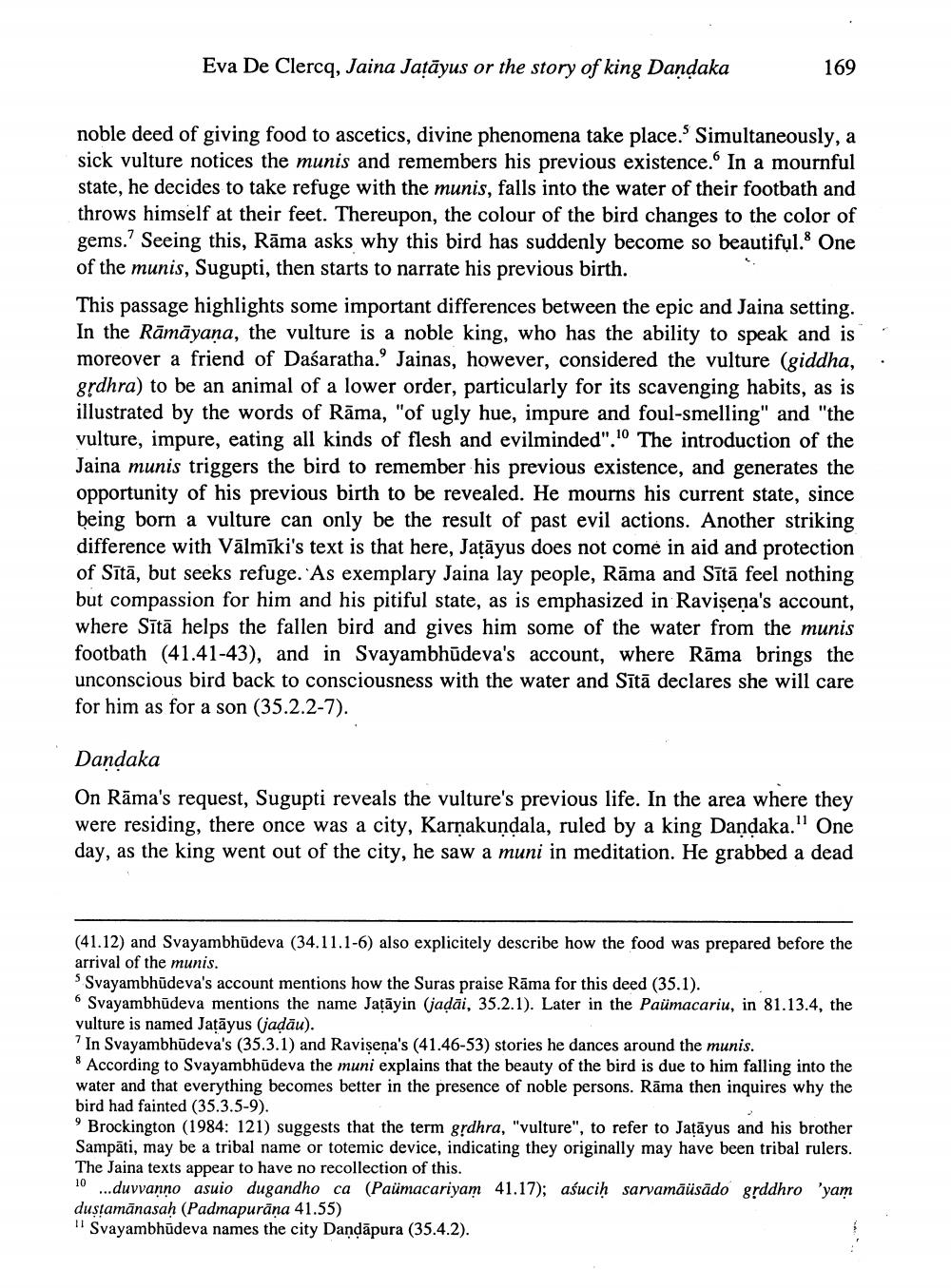________________
Eva De Clercq, Jaina Jatayus or the story of king Dandaka
169
.
noble deed of giving food to ascetics, divine phenomena take place. Simultaneously, a sick vulture notices the munis and remembers his previous existence. In a mournful state, he decides to take refuge with the munis, falls into the water of their footbath and throws himself at their feet. Thereupon, the colour of the bird changes to the color of gems.? Seeing this, Rāma asks why this bird has suddenly become so beautiful.' One of the munis, Sugupti, then starts to narrate his previous birth. This passage highlights some important differences between the epic and Jaina setting. In the Rāmāyaṇa, the vulture is a noble king, who has the ability to speak and is moreover a friend of Dasaratha. Jainas, however, considered the vulture (giddha, grdhra) to be an animal of a lower order, particularly for its scavenging habits, as is illustrated by the words of Rāma, "of ugly hue, impure and foul-smelling" and "the vulture, impure, eating all kinds of flesh and evilminded". 10 The introduction of the Jaina munis triggers the bird to remember his previous existence, and generates the opportunity of his previous birth to be revealed. He mourns his current state, since being born a vulture can only be the result of past evil actions. Another striking difference with Vālmīki's text is that here, Jatāyus does not come in aid and protection of Sītā, but seeks refuge. As exemplary Jaina lay people, Rāma and Sītā feel nothing but compassion for him and his pitiful state, as is emphasized in Ravişena's account, where Sītā helps the fallen bird and gives him some of the water from the munis footbath (41.41-43), and in Svayambhūdeva's account, where Rāma brings the unconscious bird back to consciousness with the water and Sītā declares she will care for him as for a son (35.2.2-7).
Dandaka
On Rāma's request, Sugupti reveals the vulture's previous life. In the area where they were residing, there once was a city, Karnakundala, ruled by a king Dandaka." One day, as the king went out of the city, he saw a muni in meditation. He grabbed a dead
(41.12) and Svayambhudeva (34.11.1-6) also explicitely describe how the food was prepared before the arrival of the munis. 5 Svayambhūdeva's account mentions how the Suras praise Rāma for this deed (35.1). 6 Svayambhudeva mentions the name Jatāyin (jadāi, 35.2.1). Later in the Paümacariu, in 81.13.4, the vulture is named Jatāyus (jadāu).
In Svayambhudeva's (35.3.1) and Ravişena's (41.46-53) stories he dances around the munis. & According to Svayambhudeva the muni explains that the beauty of the bird is due to him falling into the water and that everything becomes better in the presence of noble persons. Rāma then inquires why the bird had fainted (35.3.5-9).
Brockington (1984: 121) suggests that the term grdhra, "vulture", to refer to Jatāyus and his brother Sampāti, may be a tribal name or totemic device, indicating they originally may have been tribal rulers. The Jaina texts appear to have no recollection of this. 10 ...duvvanno asuio dugandho ca (Paümacariyam 41.17); asucih sarvamāüsādo grddhro 'yam dustamānasah (Padmapurāna 41.55) "Svayambhūdeva names the city Dandāpura (35.4.2).




